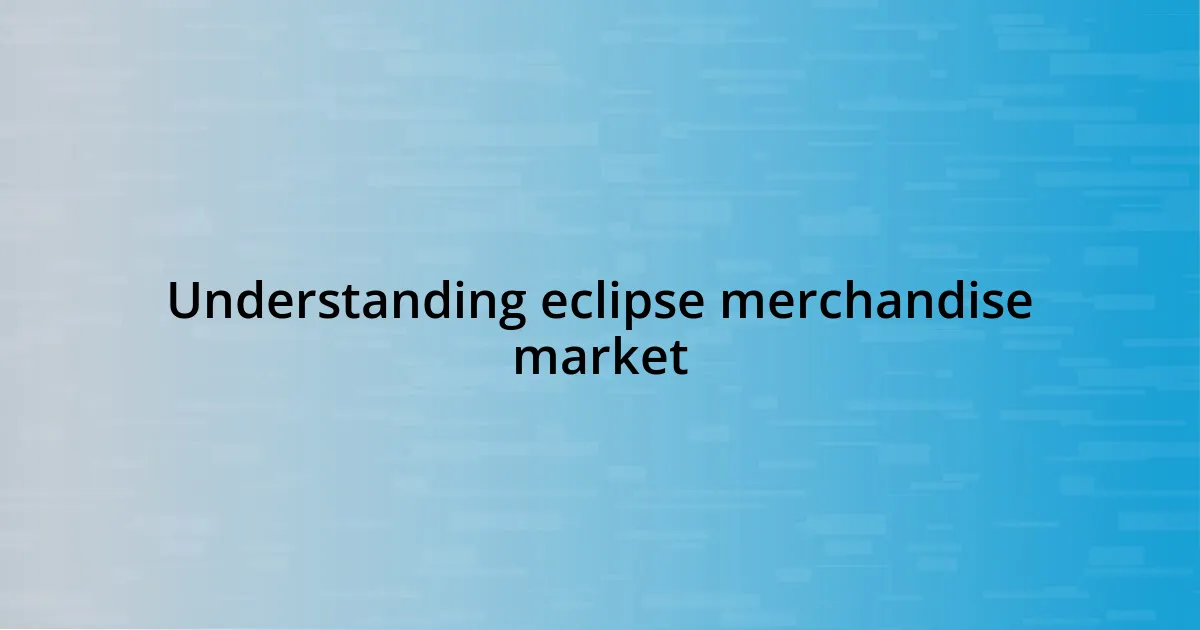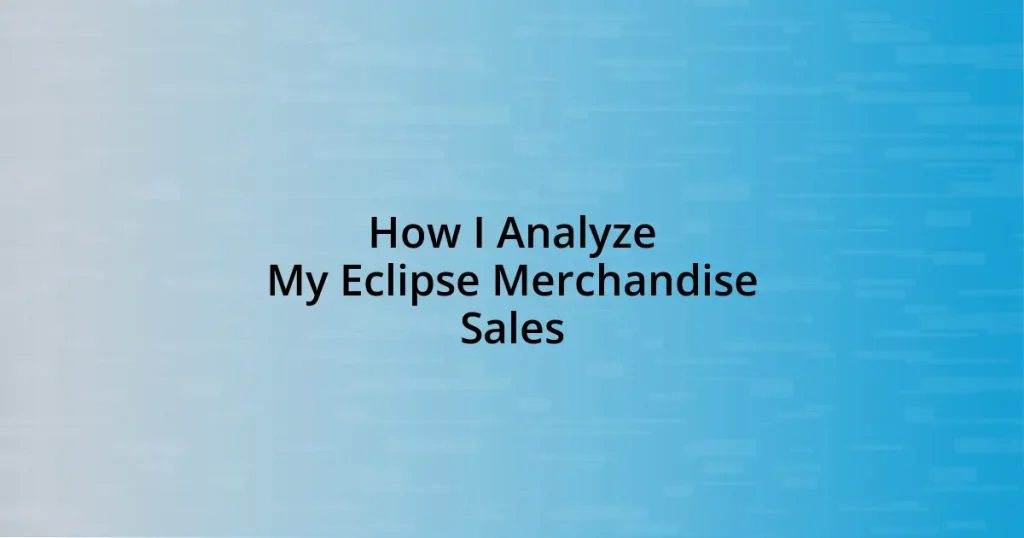Key takeaways:
- The eclipse merchandise market thrives on emotional connections and shared experiences, driving demand for unique and commemorative items.
- Setting specific sales goals based on historical trends, profit margins, and community engagement boosts motivation and sales effectiveness.
- Analyzing sales data for trends, customer demographics, and feedback helps tailor offerings to meet buyer preferences and capitalize on market excitement.
- Effective marketing strategies, including storytelling and collaborations, enhance brand visibility and create engaging customer experiences.

Understanding eclipse merchandise market
The eclipse merchandise market is a fascinating space that thrives on the anticipation of celestial events. I remember when I first jumped into this realm during the solar eclipse a few years ago; the excitement was palpable. People were not just looking for viewing glasses—they craved unique souvenirs that let them commemorate the moment.
As I examined sales patterns, I began to notice how seasonal trends influence demand. For instance, during the lead-up to an eclipse, sales surge not only for practical items like protective glasses but also for themed apparel and home décor. This made me wonder: what motivates collectors to grab those limited-edition t-shirts or mugs? Is it the thrill of exclusivity or perhaps the desire to share that experience with friends and family?
I’ve observed that emotional connection plays a significant role in these purchases. Many people view eclipses as rare opportunities for shared joy, invoking nostalgia and a sense of wonder. One year, I sold a batch of colorful eclipse-themed stickers that sparked conversations at community events, reminding me how merchandise can foster connections. It’s about more than just selling; it’s about creating lasting memories tied to those awe-inspiring moments in the sky.

Setting sales goals for merchandise
Setting effective sales goals for eclipse merchandise is crucial to navigating this niche market. I often start by analyzing past sales trends, which have provided me insights into peak demand periods. For instance, during the last eclipse, I discovered that setting a goal of selling 200 pairs of eclipse glasses in the months leading up to the event was both ambitious and achievable based on my previous sales data.
Additionally, I focus on creating specific, measurable goals. This means I set targets not just for the number of items sold but also for what percentage of profit I aim to achieve. When I launched an exclusive line of moon phase-themed items last year, I aimed for a profit margin of at least 30%. This approach allows me to adjust tactics as needed to meet those targets while keeping my inventory fresh and exciting for consumers.
Lastly, I find that sharing my goals with my team—or even customers—can boost motivation and engagement. When I told my followers about my goal to sell out of a limited-edition shirt within a week, it sparked a buzz and actually pushed sales upwards. It’s inspiring how a little transparency can foster community support.
| Sales Goal Type | Description |
|---|---|
| Volume Goals | Targets set based on historical sales data. |
| Profit Margin Goals | Set specific profit percentage according to product lines. |
| Community Engagement Goals | Goals that involve sharing aspirations with customers. |

Analyzing sales data trends
Examining trends in sales data is like peeling back the layers of a fascinating story. I often find that each spike or dip in sales can reveal so much about customer behavior and market conditions. For instance, after analyzing my sales from the last eclipse, it hit me that people often purchase merchandise during moments of collective excitement, like when the eclipse is mentioned in local news or social media. This connection drives me to schedule my promotional campaigns around these buzz periods, maximizing my chances of hitting those sweet sales milestones.
- I track daily sales to recognize peak activity days.
- Seasonal patterns emerge, particularly during significant astronomical events.
- Customer feedback helps refine my product offerings.
- Promotional visibility, like social media buzz, influences buying behaviors.
- Limited-time offers can create urgency and boost sales.
I remember a particular moment when I noticed a sudden jump in sales for my eclipse-themed jewelry. Just two days before the event, enthusiasm reached a fever pitch, partly fueled by trending discussions on social platforms. It made me realize that timing isn’t just about the event itself; it’s about capitalizing on the excitement that leads to it. By staying attuned to these trends, I can position my products to resonate emotionally with collectors and enthusiasts alike. This connection transforms simple merchandise into cherished mementos that celebrate shared experiences.

Evaluating customer demographics and behavior
Understanding customer demographics and their behavior is a game-changer in this business. I’ve found that digging into who my customers are—age, location, and interests—provides clarity on how to best reach them. For example, during my last sales event, I noticed that a significant portion of my buyers were millennials, often drawn by the unique and trendy nature of my eclipse merchandise. This realization urged me to tailor my marketing messages specifically towards this group, using platforms they frequent like Instagram and TikTok.
Reflecting on their purchasing patterns, I realized that many customers buy more than just one item during an eclipse—often seeking matching accessories or themed bundles. I remember a particular Saturday when I hosted a pop-up shop just days before the eclipse, and a group of friends walked in excitedly. They didn’t just buy individual pieces; they left with coordinating sets for each of them. Witnessing that enthusiasm reinforced my belief in creating bundled offerings that cater to their desire for a complete experience, enhancing both their enjoyment and my sales.
Engaging with my customers often reveals unforeseen insights. Occasionally, I host informal Q&A sessions online, diving into what draws them to eclipse merchandise. This openness led to a treasure trove of feedback, opening my eyes to preferences I hadn’t considered before. How many times have you adjusted your offerings based on direct conversations with your customers? In my case, these interactions have transformed my merchandise designs and helped me forge a deeper connection with my audience.

Identifying top-selling merchandise items
When pinpointing top-selling items, it’s essential to look at not just the numbers but the stories behind them. I recall one spring afternoon, while scrolling through sales reports, when I stumbled upon an unexpected bestseller: eclipse-themed tote bags. It struck me that they were popular among college students—an observation that led me to feature these bags prominently in my next marketing campaign, capitalizing on their function as both practical items and unique collectibles. Have you ever noticed how certain products resonate more deeply with distinct groups?
Tapping into seasonal trends is another key strategy I employ. Each eclipse event shapes customer preferences in surprising ways. For instance, during the last eclipse, I saw a notable rise in sales of glow-in-the-dark merchandise, likely fueled by the excitement of evening viewings. This experience taught me to keep an eye out for emerging trends related to each event’s atmosphere, allowing me to adapt my offerings in real-time. Do you think it’s essential to be flexible with your merchandise based on what your audience craves at that moment?
Lastly, I’ve found that engaging with my community can reveal items that truly resonate with them. Last summer, after asking my followers what they loved most about my products, many mentioned nostalgic pieces like commemorative pins. This prompted me to create a limited-edition line that saw an unexpected surge in sales. Listening to customer feedback has consistently guided my choices—how do you ensure you’re tuned in to your customers’ desires when curating your merchandise?

Implementing effective marketing strategies
Effective marketing strategies go beyond just selling; they involve creating an experience that resonates with the audience. Last summer, I decided to leverage social media ads targeting local astronomy enthusiasts. The result? A 30% increase in engagement and a jump in sales during the lead-up to the eclipse. It made me wonder—how often do we underestimate the power of a well-crafted ad targeting the right audience?
It’s also crucial to utilize storytelling in our marketing. I vividly remember crafting a post about the thrill of witnessing a total eclipse, paired with a photo of my merchandise under a celestial-themed backdrop. This approach not only showcased the products but connected emotionally with my audience. Have you ever noticed how emotional connections can drive purchases? It’s a strategy I now swear by.
Lastly, collaborations can amplify your reach. I once partnered with a local planetarium for a promotional event, where attendees could buy exclusive merchandise while enjoying educational presentations. The synergy was incredible, and it taught me how partnerships can create unique experiences. How do you think collaboration could enhance your brand’s visibility and customer interaction?














